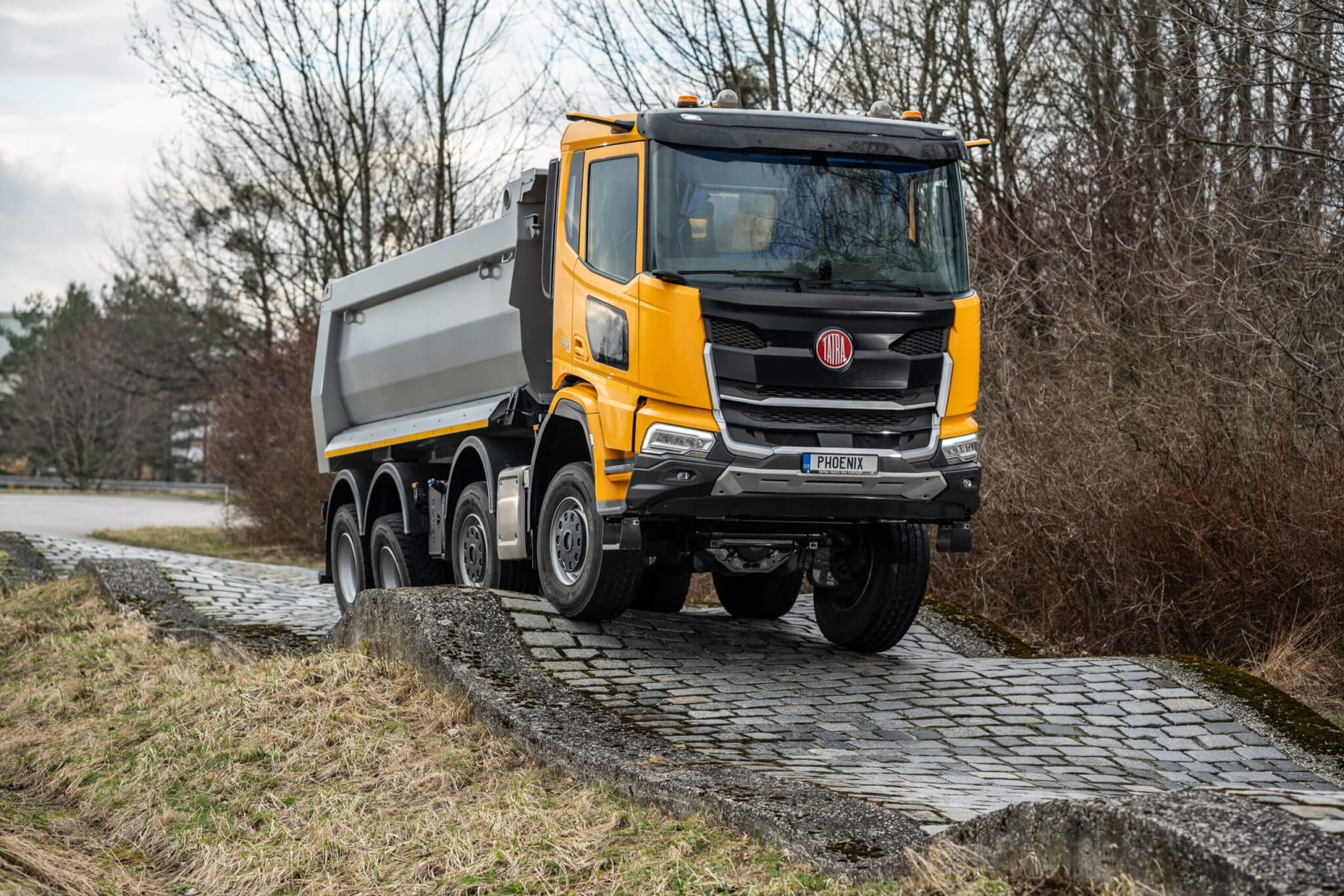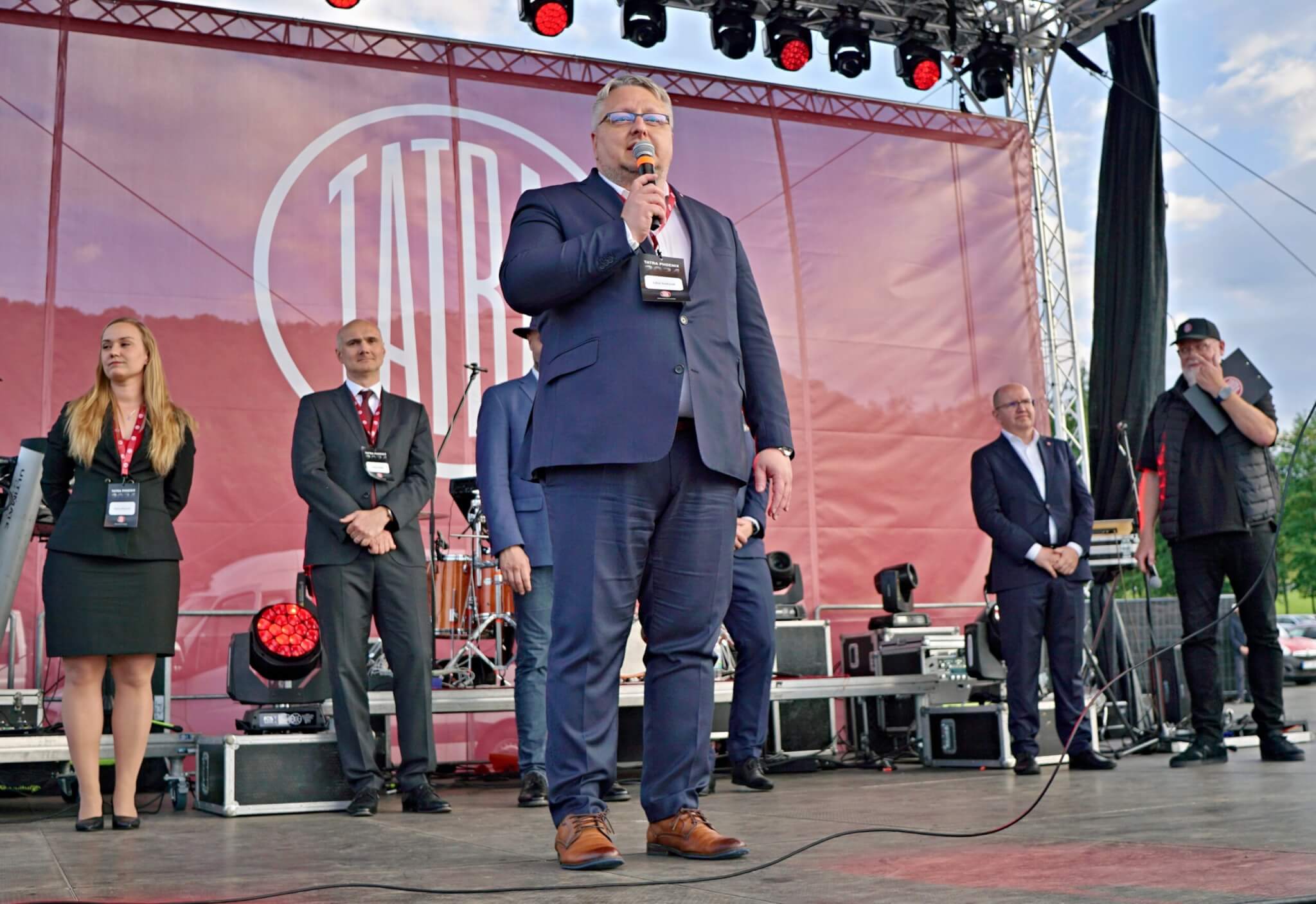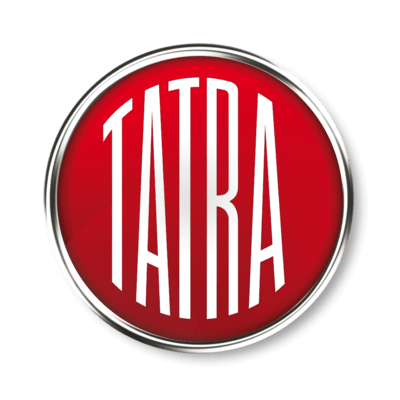Tatra Trucks has introduced the latest generation of the Tatra Phoenix model range, which builds on proven foundations while introducing many new features that improve comfort, safety and efficiency. Series production will begin in the summer. At the same time, the carmaker continues to develop vehicles with alternative drives.
In the presence of the company’s management, representatives of the Moravian-Silesian Region and other guests, Tatra Trucks unveiled the new generation of the Tatra Phoenix model series at the beginning of June on its company polygon.
New generation in summer series
The development of the new generation of the Tatra Phoenix model series has been underway since 2022, and like the previous generations, this new model retains the Tatra chassis concept with a central load tube and exclusively air-suspended independently suspended semi-axles. As usual, the cabs and engines are from long-standing Dutch partner DAF Trucks.
The new generation of Tatra Phoenix trucks is equipped with innovative Paccar engines that use the latest technology and design features. Automated ZF TraXon transmissions will be available as standard, with the option of installing fully automatic Allison transmissions available on request.
The new Phoenix uses the DAF XDC cab (Construction Series), which has been developed for maximum safety, durability and comfort, providing better visibility and all-round visibility and is aerodynamically optimised for the lowest possible fuel consumption.

Tatra Phoenix on the test polygon. | Photo: Tatra
Innovations have also been made in the area of electronic and assistance systems. These include an automatic windscreen wiper control system, an automatic exterior lighting switching system and Corner View, which eliminates blind spots on both the driver’s and passenger’s sides.
The Tatra Phoenix range is one of the pillars of the company’s production portfolio and is intended primarily for the civilian market, but is also used by rescue and firefighters and defence forces. Serial production will begin this summer, with the first units of the new vehicles reaching customers in the autumn of this year.
Hydrogen vehicle being tested
In addition to the production of standard trucks, Tatra Trucks has been intensively developing vehicles with alternative drive types in recent years.
In April, it exhibited the Tatra Force e-Drive FCEV, a prototype heavy-duty truck powered by an electric traction engine combined with hydrogen fuel cells, at Automotive Day 2024.
The hydrogen-based Tatra Force is based on the third generation of this popular model series introduced last year. The prototype’s propulsion is electric, but it is designed to be independent of external power sources. Therefore, in addition to a traction electric motor, traction batteries and two fuel cells, it also features pressurised gaseous hydrogen tanks.

Hydrogen Tatra Force e-Drive FCEV. | Photo: Tatra Trucks
According to Tatra representatives, the flexibility of the car will be comparable even to cars with conventional internal combustion engines if an infrastructure with hydrogen filling stations is built. The vehicle uses an eight-wheel chassis of the Tatra concept with a central support tube and swinging independently suspended semi-axles in a 1+3 configuration and three-axle drive. The prototype is designed as a truck for use in the mining industry with a total weight of 45 tonnes. Tatra wants to test various technologies on it in the most demanding operating conditions.
Tatra is currently running a demanding test programme to verify the operational and technical parameters of this hydrogen vehicle, the Tatra Force.
Subsidies for an electric car
Tatra Trucks’ strategy for the development of vehicles with low-emission drive systems also includes the development of the Tatra Force e-Drive 8×8 heavy-duty truck using a fully electric battery drive system in combination with an Eaton multi-speed transmission. For this work, the carmaker managed to obtain a grant from the TREND programme of the Technology Agency of the Czech Republic.
Tatra Trucks is cooperating on the battery electric vehicle project with Devinn and the Czech branch of the multinational corporation Eaton. The prototype vehicle with a fully electric battery drive system with Eaton’s multi-speed transmission will be based on the latest third generation of the Tatra Force model series, which was first presented to the public in the middle of last year.
“We are working very hard on projects that will deliver vehicles that will meet the upcoming stringent legislative standards as well as the ever-increasing customer demands,” said Lukáš Andrýsek, Chairman and CEO of Tatra Trucks.
Tatra’s management is aware that modern technology and top quality of Tatra vehicles are the prerequisites for the automaker’s competitiveness on the market, and at the same time it perceives its social responsibility in the area of reducing the environmental impact of automotive transport.
“We carry out research and development of alternative drives far beyond the standard approach of other truck manufacturers, as well as suppliers of relevant technology and accessories. This is because our vehicles are often driven over difficult terrain, often in difficult weather, temperature and dust conditions, and have to overcome off-road obstacles that involve relatively large longitudinal and lateral gradients and steep gradients. We cooperate with both the academic and research spheres and a number of Czech and international institutions on the development of individual alternative drive trains,” said Radomír Smolka, member of the Board of Directors of Tatra Trucks responsible for development projects.
Restructuring as a condition for increased production
The increasing demand for Tatra vehicles has now pushed the company to the limit of its production capacity. In order to meet customer demand over the next few years, it must dramatically increase production volumes. It has therefore started a process of restructuring and is investing in production capacity and technology. Last year, Tatra produced a total of 1,451 vehicles, and this year it should increase by hundreds more.
“The restructuring steps we have been taking since the middle of last year and the monitored production and order parameters are very good preconditions for us to be able to fulfil our plans. We are at the beginning of a process that should help us reach production and sales volumes of 2,500 vehicles per year in about two to three years,” explained Tatra Trucks CEO Lukáš Andrýsek.

Tatra Trucks CEO Lukáš Andrýsek at the launch of the new Tatra Phoenix. | Photo: Tatra Trucks
The main part of the changes in Tatra Trucks are new organisational principles, investments in production capacities and new machine technologies. Major changes will also take place in the infrastructure of the automotive plant. “We have developed and implemented a new Target Operating Model for the organisation. The newly created areas of project management, purchasing, technical department, logistics and quality lead to efficient management of our company,” said Petr Buršík, CEO of Tatra Trucks. In the new model, the project team is responsible for order execution, which, together with the newly formed process engineering of the technical department and other measures, increases production efficiency.
In addition, Tatra Trucks is also building a strong supplier base, as explained by Purchasing Director Zuzana Švidrnochová: “We are creating strategic partnerships and successfully strengthening the stability of supply of parts that we need for the smooth running of production processes. In all this, we are also taking into account new regions where we did not have partners before.”
Investment in technology and equipment
Necessary conditions for increasing production are modernisation and automation of production. Investments in new high-tech machinery should reach CZK 700 million. Part of the machinery has already been installed by the company last year, another part will be installed this year.
“We plan to strengthen the capacity of the so-called bottlenecks in the production process and automate the places with large time losses in production so that we can reach the world level of machining. The machining of carrier tubes will be supported by a new Fénix 2 machining centre including a robotic welding unit for CZK 41 million, and we also plan to automate and streamline gear machining with new Gleason machine tools for almost CZK 90 million. We are also preparing the automation of engine machining with new automated CNC equipment for CZK 73 million, which will replace the line from the 1960s,” says Tomas Prášil, Technical Director of Tatra Trucks.
Last year, Tatra Trucks also invested almost CZK 100 million in development and testing equipment. This involved the purchase and commissioning of a new test bench for gear units and a test bench for engine testing. The volume of investment is expected to be even higher this year. “The most important ones are the construction of a completely new engine test facility, including its equipment, the purchase of a machining centre for the prototype workshop and the continuation of the renewal of the equipment in the dynamic and vehicle test facilities,” said Radomír Smolka, Tatra Trucks’ director of research and development and a member of the company’s board of directors.
New offices in Brno and Ostrava
Part of the restructuring processes and investments in Tatra is also the creation of new workplaces outside the town of Kopřivnice. Last October, the company opened a branch of the Tatra development centre in Brno, and this year another one will be opened in Ostrava. With this move, Tatra is targeting development experts and students from these catchment areas.
The Brno branch is primarily used by engine and transmission designers, as Tatra continues to develop and produce its own engines and transmissions for its vehicles. These are important components not only in terms of the overall technological design of the vehicles, but also in terms of the production self-sufficiency of the automaker.
The capacity of the Brno office is not yet fully filled, and the carmaker is still looking for computer engineers, electrical engineers, software developers and engineers with a focus on engines and transmissions.
There are several reasons for setting up a development centre in Brno, but first of all it is a large city where diverse research and development is concentrated, where technical universities are located, especially the Faculty of Mechanical Engineering of the Brno University of Technology, and it also offers greater connections to business contacts and opportunities than Kopřivnice. Already now the design office cooperates with both engineering students of the Brno University (in the form of diploma theses, with internships planned for the future) and PhD students.
Similar reasons lead to the establishment of a branch in Ostrava.
Success depends on people
Tatra Trucks has already announced two significant personnel changes this year. Since the beginning of March, Jakub Pončík, who joined the oldest Czech carmaker in 2016, has been the new Research and Development Director of Tatra Trucks. Until now, this position was held by Radomír Smolka, whose new role as a member of the company’s board of directors responsible for development projects and research shifts to the level of strategic planning and decision-making. Jakub Pončík has thus become the youngest R&D director in Tatra’s history at the age of 30.
In his role, Jakub Pončík has so far worked on a number of projects, such as the construction of the Tatra Force e-Drive FCEV prototype with hydrogen fuel cells and a logistics vehicle project for the Belgian army. He was also involved in setting up a branch of Tatra’s design office in Brno, which specialises in gearboxes and engines.
There has also been a change in Tatra’s marketing director. In May, Jan Kadlec, an experienced manager who had already worked at Tatra from 2010 to 2013, took over. At that time, his main project was the launch of the new Tatra Phoenix model range. In 2012, it won the International Truck of the Year award for the best all-wheel drive truck of the year.
 Red dot for design. For the first time in its history, the Kopřivnice-based Tatra Trucks has been awarded the Red Dot award in the Product Design category twice. This award, which is one of the most prestigious in the international design sector, was presented to the latest third generation Tatra Force trucks, with a four-door cab version and a version of the development line called e-Drive with an electric traction engine and hydrogen fuel cells.
Red dot for design. For the first time in its history, the Kopřivnice-based Tatra Trucks has been awarded the Red Dot award in the Product Design category twice. This award, which is one of the most prestigious in the international design sector, was presented to the latest third generation Tatra Force trucks, with a four-door cab version and a version of the development line called e-Drive with an electric traction engine and hydrogen fuel cells.
 In addition to standardised model lines, Tatra Trucks also produces special trucks tailored to customer requirements. The domestic markets in the Czech Republic and Slovakia are very important, and a large part of the company’s production is intended for export to dozens of countries around the world. The carmaker employs more than 1,400 people, and more than 700 others work in the Tatra Metalurgie subsidiary, which focuses mainly on foundry and forging. The shareholders of Tatra Trucks are the industrial-technological holding Czechoslovak Group and the engineering group Promet Group.
In addition to standardised model lines, Tatra Trucks also produces special trucks tailored to customer requirements. The domestic markets in the Czech Republic and Slovakia are very important, and a large part of the company’s production is intended for export to dozens of countries around the world. The carmaker employs more than 1,400 people, and more than 700 others work in the Tatra Metalurgie subsidiary, which focuses mainly on foundry and forging. The shareholders of Tatra Trucks are the industrial-technological holding Czechoslovak Group and the engineering group Promet Group.
Contact
Next articles and interviews
Next articles and interviews
+ Show




 Red dot for design. For the first time in its history, the Kopřivnice-based Tatra Trucks has been awarded the Red Dot award in the Product Design category twice. This award, which is one of the most prestigious in the international design sector, was presented to the latest third generation Tatra Force trucks, with a four-door cab version and a version of the development line called e-Drive with an electric traction engine and hydrogen fuel cells.
Red dot for design. For the first time in its history, the Kopřivnice-based Tatra Trucks has been awarded the Red Dot award in the Product Design category twice. This award, which is one of the most prestigious in the international design sector, was presented to the latest third generation Tatra Force trucks, with a four-door cab version and a version of the development line called e-Drive with an electric traction engine and hydrogen fuel cells. In addition to standardised model lines, Tatra Trucks also produces special trucks tailored to customer requirements. The domestic markets in the Czech Republic and Slovakia are very important, and a large part of the company’s production is intended for export to dozens of countries around the world. The carmaker employs more than 1,400 people, and more than 700 others work in the Tatra Metalurgie subsidiary, which focuses mainly on foundry and forging. The shareholders of Tatra Trucks are the industrial-technological holding Czechoslovak Group and the engineering group Promet Group.
In addition to standardised model lines, Tatra Trucks also produces special trucks tailored to customer requirements. The domestic markets in the Czech Republic and Slovakia are very important, and a large part of the company’s production is intended for export to dozens of countries around the world. The carmaker employs more than 1,400 people, and more than 700 others work in the Tatra Metalurgie subsidiary, which focuses mainly on foundry and forging. The shareholders of Tatra Trucks are the industrial-technological holding Czechoslovak Group and the engineering group Promet Group.







